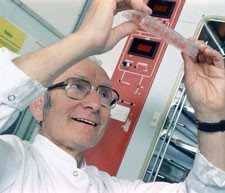
César Milstein (1927–2002) | Nature
- Select a language for the TTS:
- French Female
- French Male
- French Canadian Female
- French Canadian Male
- Language selected: (auto detect) - FR
Play all audios:
Access through your institution Buy or subscribe Milstein was born into a Jewish family in Bahía Blanca, Argentina, and graduated from the University of Buenos Aires with a thesis on
aldehyde dehydrogenase. In 1958, he won a scholarship to work at the University of Cambridge in Britain, where he did a second PhD, again in enzymology. There he met Fred Sanger, who had
just won his first Nobel prize for determining the structure of insulin. Meeting Sanger was critical for Milstein's career. He returned to Argentina in 1961, but soon became
dissatisfied with the political climate and, in 1963, took up Sanger's invitation to join the Medical Research Council's Laboratory of Molecular Biology (LMB), which had already
attracted other top scientists from abroad such as Max Perutz, Aaron Klug and Sydney Brenner. It was on Sanger's advice that Milstein then began to study antibody structure and
diversity: this was to be his life's work, with LMB in Cambridge his scientific home. Milstein's hope was that the structural comparison of different antibodies would reveal the
secret of antibody diversity. But things turned out to be more complicated. Soon after his arrival in Cambridge, it was discovered that antibody molecules contained variable (_V_) and
constant (_C_) regions and the 'two genes, one polypeptide' hypothesis was proposed. According to this idea, separate genes encode _V_ and _C_ regions, and there are thousands of
_V_ genes in the germ line — the set of genes inherited by offspring. This was shockingly unorthodox, and other ideas were put forward. Among them, in 1966, was Brenner and Milstein's
proposal of a mechanism that introduces 'somatic' (non-germline) mutations selectively into _V_ segments of antibody genes. This proposal proved inadequate to explain primary
antibody diversity. But it later became a leading model for the diversification of antibodies in immune responses, the main subject of Milstein's research for the latter part of his
life. This is a preview of subscription content, access via your institution ACCESS OPTIONS Access through your institution Subscribe to this journal Receive 51 print issues and online
access $199.00 per year only $3.90 per issue Learn more Buy this article * Purchase on SpringerLink * Instant access to full article PDF Buy now Prices may be subject to local taxes which
are calculated during checkout ADDITIONAL ACCESS OPTIONS: * Log in * Learn about institutional subscriptions * Read our FAQs * Contact customer support AUTHOR INFORMATION AUTHORS AND
AFFILIATIONS * the Center for Blood Research, Harvard Medical School, 200 Longwood Avenue, Boston, 02115, Massachusetts, USA Klaus Rajewsky Authors * Klaus Rajewsky View author publications
You can also search for this author inPubMed Google Scholar CORRESPONDING AUTHOR Correspondence to Klaus Rajewsky. RIGHTS AND PERMISSIONS Reprints and permissions ABOUT THIS ARTICLE CITE
THIS ARTICLE Rajewsky, K. César Milstein (1927–2002). _Nature_ 416, 806 (2002). https://doi.org/10.1038/416806a Download citation * Issue Date: 25 April 2002 * DOI:
https://doi.org/10.1038/416806a SHARE THIS ARTICLE Anyone you share the following link with will be able to read this content: Get shareable link Sorry, a shareable link is not currently
available for this article. Copy to clipboard Provided by the Springer Nature SharedIt content-sharing initiative